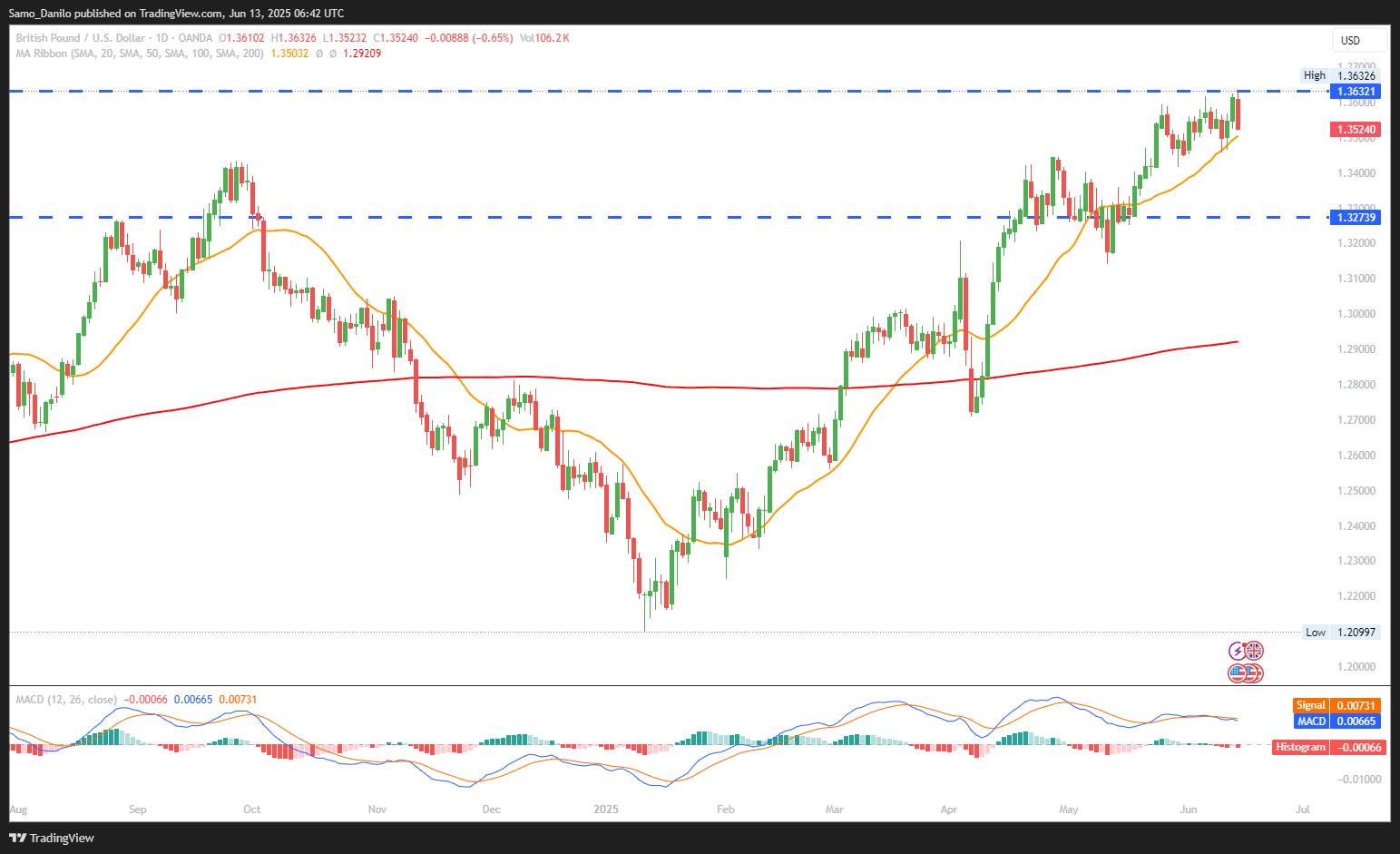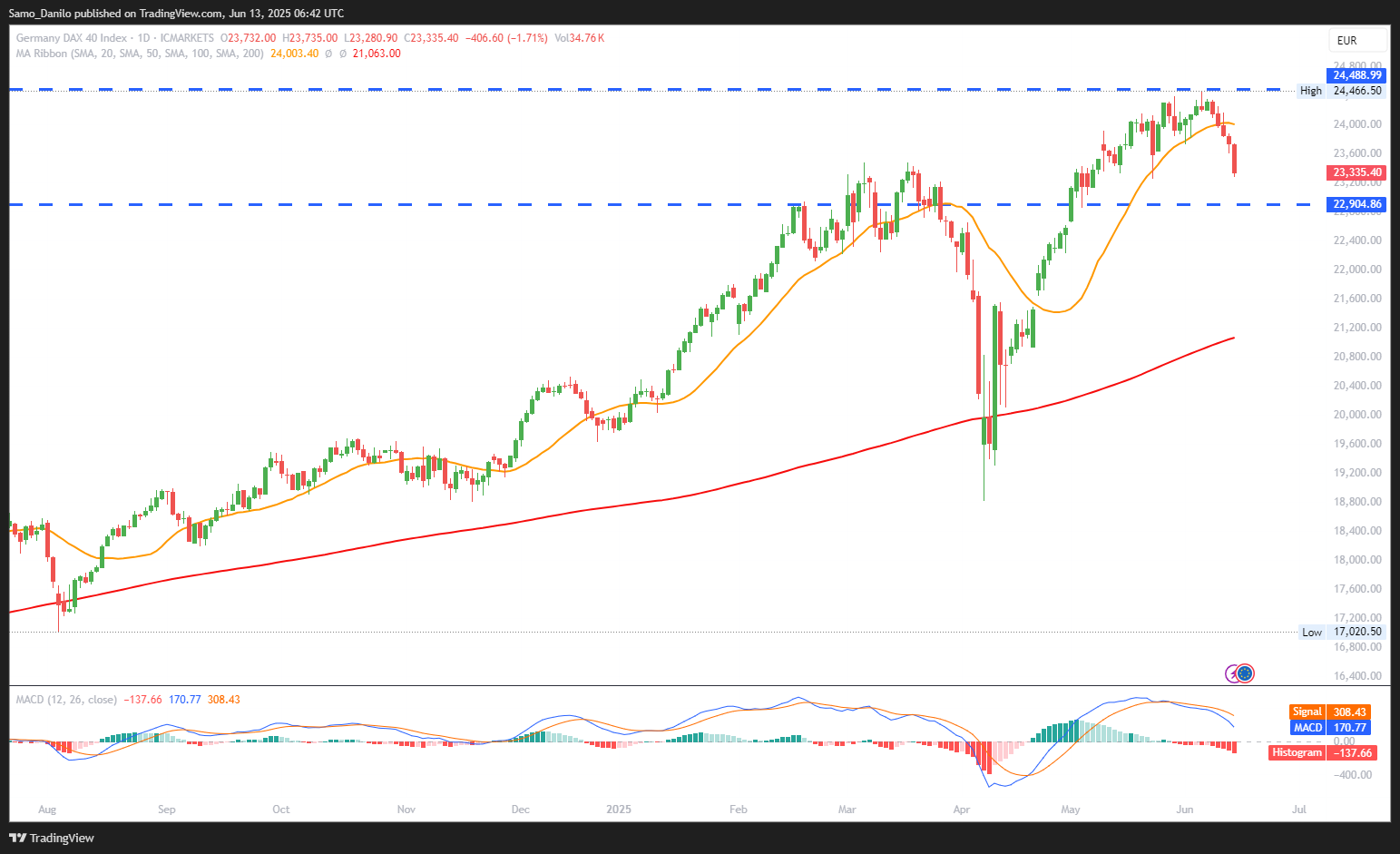EURUSD
- EUR/USD Price: The EUR/USD pair is trading deep in the red near 1.1500, extending its pullback from multi-year highs during Friday’s European session. The move reflects a broader risk-off sentiment, as traders pare back euro bullish bets.
- Middle East Escalation: A preemptive Israeli strike on Iranian nuclear sites has intensified geopolitical tensions. Israel's defense minister declared a state of emergency, warning of potential retaliatory missile and drone attacks, pushing markets toward safe-haven flows and hurting high-beta currencies like the euro.
- Tariff Threats: President Trump’s latest threat to expand steel tariffs from June 23, now targeting “steel derivative products” like household appliances, has revived fears of a broader global trade war, further weighing on the EUR/USD amid uncertainty over EU export exposure.
- ECB’s de Guindos: While ECB board members signaled that the monetary easing cycle is nearing its end, Vice President Luis de Guindos expressed concern over weakening economic momentum. This mixed messaging has created divergent expectations and is contributing to EUR volatility.
- ECB’s Schnabel: ECB’s Isabel Schnabel stated that medium-term inflation is stabilizing around target, justifying a potential pause in cuts. However, the broader market remains cautious, balancing between inflation progress and deteriorating economic activity within the Eurozone.
Closing statement: The EUR/USD is under sustained selling pressure, driven by a mix of geopolitical escalation, renewed trade war fears, and cautious central bank signaling. While ECB hawkishness offers some long-term support, near-term sentiment remains bearish, with downside risks mounting amid global uncertainty.
GBPUSD
- GBP/USD Price: The GBP/USD pair extends its decline, falling to around 1.3530 during Friday’s European session. The British Pound is weighed down by broader market caution and shifting sentiment on US interest rates.
- Middle East Tensions: A unilateral Israeli strike on Iran has fueled geopolitical instability, with US officials distancing themselves from the action. Secretary of State Marco Rubio emphasized US non-involvement, underscoring Washington’s focus on protecting American troops. This backdrop has triggered a flight to safety, pressuring risk-sensitive assets like the pound.
- Trump's Stance: President Donald Trump reiterated that Iran “cannot have a nuclear bomb”, though he expressed hope for a peaceful resolution. These remarks contribute to market uncertainty and reinforce safe-haven flows into the US Dollar.
- US PPI Data: Thursday’s cooler-than-expected US PPI inflation supported the case for a Fed rate cut later this year. This initially pressured the USD, though its safe-haven demand amid geopolitical unrest is currently offsetting that weakness.
- US Sentiment Data: Attention will turn to the University of Michigan Consumer Sentiment Index, due later in the session. The report could sway Fed rate expectations and influence short-term GBP/USD price action.
Closing statement: GBP/USD is trending lower, caught between rising geopolitical risks and a shifting US interest rate outlook. While softer inflation data offers some relief, broader risk aversion is dominating, favoring the USD and suggesting continued downside pressure on the pound in the near term.
XAUUSD
- XAU/USD Price: Gold (XAU/USD) is trading just below seven-week highs, consolidating around $3,445 early Friday. The 14-day RSI remains elevated at 62, indicating strong bullish momentum with further room to climb if market conditions support safe-haven flows.
- US PPI Data: The US Producer Price Index (PPI) rose by 0.1% MoM in May, slightly below expectations. The upward revision to April’s data, however, softens the disinflation narrative somewhat. Still, the overall picture continues to support rate cut expectations by September, which is favorable for gold.
- Israel Signals: Israeli Prime Minister Netanyahu warned the military campaign “will take many days,” preparing for expected retaliation from Iran. These statements reinforce geopolitical anxiety, supporting gold as a safe-haven asset.
- Iran Threats: Iran's Armed Forces declared that the US and Israel would receive a “harsh blow”, in response to Israeli aggression. The elevated Middle East tension is a key driver of demand for safe assets, keeping gold prices well-supported.
- US Sentiment Data: The upcoming University of Michigan Consumer Sentiment and Inflation Expectations data is unlikely to move markets significantly, as geopolitical headlines dominate sentiment, particularly regarding escalation risk in the Middle East.
Closing statement: Gold remains resilient amid rising geopolitical tensions and steady US data. While softer PPI supports the Fed doves, the ongoing Iran-Israel conflict is the primary catalyst, keeping XAU/USD supported near recent highs with potential for further gains if risks escalate.
CRUDE OIL
- Crude Oil Price: West Texas Intermediate (WTI) crude oil extends its rally, climbing to $71.20 in Friday's European session — the highest level in four months. The surge reflects both rising geopolitical risks and a tightening global supply outlook.
- Nuclear Facility: Iran’s Atomic Energy Chief confirmed the complete destruction of the Natanz nuclear facility, a critical site for its nuclear program. Supreme Leader Ayatollah Khamenei vowed severe retaliation, intensifying Middle East tensions. The oil market has reacted strongly to these developments, with fears of supply disruptions.
- Nuclear Talks: According to Iran International, Tehran will not proceed with a sixth round of talks with the US, citing Israeli aggression. This breakdown in diplomacy undermines hopes for the removal of US sanctions on Iranian oil, reinforcing upside pressure on prices.
- Broader Tariffs: President Trump expanded the 50% steel tariffs to include certain household appliances, while Commerce Secretary Howard Lutnick confirmed Chinese tariffs remain fixed at 55%. These developments reflect a persistent hardline trade stance, though secondary to oil-specific geopolitical drivers for now.
- Supply Shocks: With no diplomatic relief in sight, markets are increasingly pricing in a scenario of regional escalation, which could disrupt crude supply flows — especially through the Strait of Hormuz, a key chokepoint.
Closing statement: Crude oil prices are climbing sharply on Middle East conflict escalation and diplomatic fallout. As prospects for Iranian supply relief fade and geopolitical risk premiums rise, WTI remains well bid, with the potential to extend gains if tensions further intensify.
DAX
- DAX Price: The DAX index fell 0.74% on Thursday, extending its five-day losing streak and settling at 23,772. The continued decline reflects persistent risk aversion driven by geopolitical instability and trade policy uncertainties.
- Auto and Tech Sectors: Trump’s renewed tariff threats and escalating Middle East tensions weighed on auto and tech stocks. Infineon (-2.39%), SAP (-0.76%), and key automakers like Volkswagen, BMW, and Mercedes-Benz all posted losses. In contrast, defense stock Rheinmetall gained 1.63%, reflecting a defensive rotation amid geopolitical risk.
- German Inflation: Final CPI data for May confirmed a 2.1% YoY rise, aligning with preliminary estimates. However, core inflation remains sticky at 2.8%, leaving the ECB cautious despite maintaining a pause on rate changes through the summer.
- Wholesale Price Index: Germany’s Wholesale Price Index fell -0.3% MoM in May, following a -0.1% drop in April. Despite consecutive monthly declines, the index remains at its highest level since February, highlighting ongoing price pressures in key industrial inputs.
- US Consumer Sentiment: Markets await the University of Michigan Consumer Sentiment Index, expected to rise from 52.2 to 53.5. While a modest improvement, the figure will help gauge broader risk sentiment and could influence global equity momentum.
Closing statement: The DAX remains under pressure as trade tensions, high core inflation, and geopolitical instability sap investor confidence. Sector rotation toward defensive names continues, with the index vulnerable to further downside unless sentiment stabilizes.




